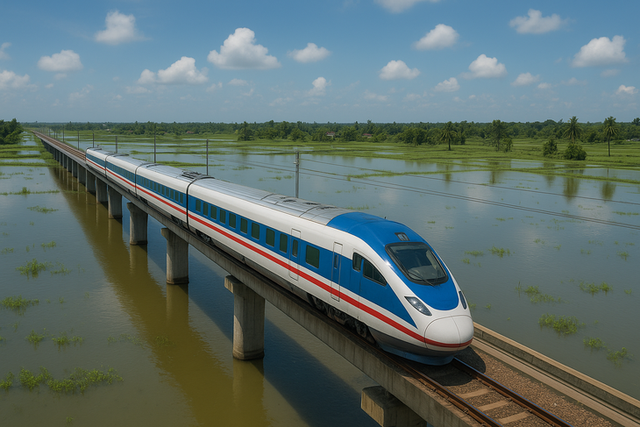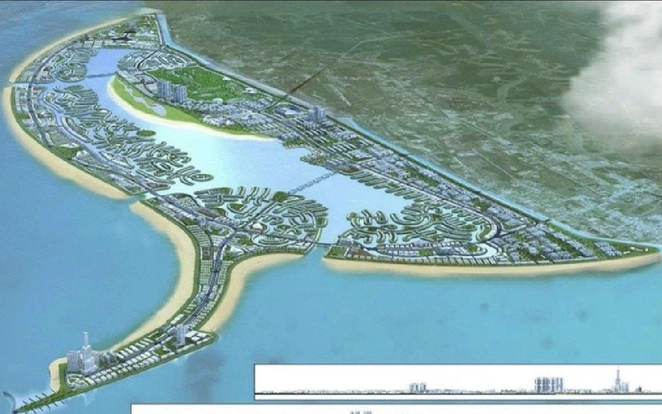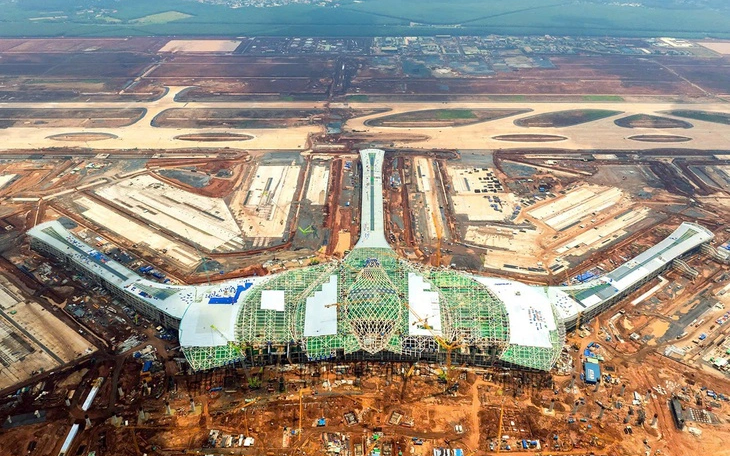
Ho Chi Minh City-Can Tho railway expected to be century-defining project of southern Vietnam
When it comes to the Mekong Delta's dream of transformation, people often think of bridges stretching across rivers or expressways reaching out to the sea. But if one project truly has the potential to reshape the region’s development, it is the Ho Chi Minh City-Can Tho railway.

The proposed Ho Chi Minh City-Can Tho railwa seen in this AI-generated illustration would be designed for speeds of up to 160 kilometers per hour.
In April this year, Prime Minister Pham Minh Chinh urged the Ministry of Construction to coordinate with relevant ministries and provinces to study and prepare for this railway project, aiming to break ground in 2027.
The My Thuan Project Management Board has since completed a pre-feasibility study.
According to the management board, the 175.2-kilometer double-track railway will start at An Binh Station in Ho Chi Minh City and end at Can Tho Station in Can Tho City, southern Vietnam.
The line will run through five provinces and cities, including Ho Chi Minh City, Tay Ninh, Dong Thap, Vinh Long, and Can Tho.
It will be a standard-gauge, electrified railway with a track gauge of 1,435 millimeters, designed for trains running up to 160 kilometers per hour, carrying both passengers and freight.
The route includes 12 main stations (with four more planned), three depots in An Binh, Tan Kien, and Can Tho, as well as four maintenance facilities in Thanh Duc, Tam Hiep, Cai Lay, and Binh Minh.
Three major bridges will span the Saigon, Vam Co Dong, and Vam Co Tay Rivers, and two large bridges will cross the Tien and Hau Rivers.
Catalyst for a new regional structure
More than a transport project, the Ho Chi Minh City-Can Tho railway represents a vital economic corridor connecting the southern region’s two most dynamic urban centers.
It is envisioned as the lifeline that will help restructure the development space of the entire Mekong Delta.
For decades, southern Vietnam’s transportation system has relied heavily on roads and waterways, with such methods once fitting for an agrarian economy.
But as the region shifts toward industry and services, these modes are no longer sufficient for the demands of speed and reliability in modern logistics.
A railway can help reduce millions of metric tons of freight from overburdened highways, cut logistics costs, and enable sustainable regional connectivity.
More broadly, it is a tool for rebalancing national development.
While Ho Chi Minh City struggles with overcrowding, infrastructure strain, and pollution, many Mekong Delta provinces remain fragmented and underinvested.
Improved infrastructure could encourage capital, labor, and knowledge to flow more evenly, forming satellite cities, logistics hubs, and industrial clusters along the route.
This would help ensure balanced and inclusive growth across the southern region.
Funding and feasibility
However, the railway faces two major challenges, including funding and feasibility.
With a projected price tag of VND238.616 trillion (US$9 billion), the project cannot rely solely on the state budget.
A public-private partnership model, built on transparency, flexibility, and risk-sharing, will be essential.
The state should take the lead by investing in core infrastructure, land clearance, and social safety, while private enterprises handle operations, logistics, and commercial development.
Clear, consistent policies and long-term commitments are crucial to building investor confidence.
Equally important is financial planning. Revenue projections, passenger and cargo volumes, fares, and maintenance costs must be realistic.
Mechanisms for minimum revenue guarantees or risk-sharing between the government and investors should be established to avoid half-finished megaprojects.
A phased investment approach could be viable, starting with a single-track, moderate-speed system, then expanding once passenger and cargo demand grows.
Land clearance: Toughest hurdle
The project is expected to affect more than 10,000 households across multiple provinces, each with its own procedures and compensation frameworks.
Without special policies and strong political will, land clearance alone could take years.
Transparency and consensus are key.
Locals must understand the project’s long-term benefits, receive fair compensation, and have stable resettlement options.
Public participation and oversight will be vital to ensure smooth implementation.
More than a railway
The Ho Chi Minh City-Can Tho railway is considered a test of governance, vision, and political determination.
It reflects a shift in mindset from short-term fixes to strategic regional planning that values sustainability and equity.
If pursued with accountability, this railway could become a ‘project of the century’ for southern Vietnam, not just linking the two cities, but connecting people, aspirations, and hope across a region ready to rise.
Pham Viet Thuan / Tuoi Tre News

